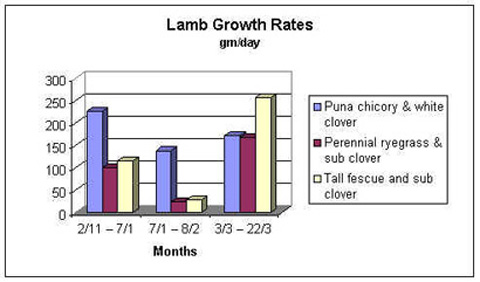
Chicory Part A - Summary
The following information forms Part A of Agfact P2.5.40 Chicory.

Chicory is a perennial herb, which has proven to be an excellent source of high quality feed for finishing stock. Experience with Puna chicory has demonstrated that it has potential for high levels of production over spring and summer, with vegetative growth being at least equal to lucerne.
Chicory tolerates soil acidity and has been successfully grown in many tablelands districts with low pH soils. Chicory is seen to be particularly important for districts where low pH is preventing the successful establishment of lucerne.
Chicory has a good disease resistance and insect tolerance, and with appropriate grazing management can provide viable stands for many years.
Chicory is able to set seed after experiencing a cold period (in the second year if spring-sown), allowing stand populations to be increased. Chicory grows actively over spring and summer, with growth tapering off as the frequency of frosts increases in late autumn. Chicory may make some growth in regions of mild winter temperature; however, in tableland areas, most chicory will be dormant over winter. In the active growth periods (spring, summer and early autumn), chicory will respond to rainfall, its long taproot (>1.5 metres) allowing soil moisture to be utilised down the profile. Chicory is not a legume, and for maximum production will require strategic applications of nitrogen. Application of phosphorus and other fertilisers may also be required in order to achieve maximum production potential.
Chicory and red or white clover are recommended companions, with the clover supplying both quality feed, and nitrogen for chicory growth. Trials have indicated that chicory/white clover pasture will enable up to three times the number of lambs to be finished to elite specifications when compared to perennial ryegrass/sub clover or tall fescue/sub clover pastures (see Figure A1).

If sown with other perennial pasture companion species, grazing management (particularly over the winter-dormant period) should aim to protect the crown of chicory plants to ensure persistence. In order to maintain high levels of production and ensure stand longevity, a rotational grazing system similar to that suitable for lucerne is recommended for chicory pastures.
In brief, chicory provides an opportunity to produce large quantities of high quality stock-finishing feed over spring and summer, and is a suitable alternative in areas where acid soil conditions do not allow lucerne to be grown.
Cautions
Always read the label
Users of agricultural (or veterinary) chemical products must always read the label and any Permit before using the product, and strictly comply with the directions on the label and the conditions of any Permit. Users are not absolved from compliance with the directions on the label or the conditions of the permit by reason of any statement made or omitted to be made in this publication.
Pasture improvement
Pasture improvement may be associated with an increase in the incidence of certain livestock health disorders. Livestock and production losses from some disorders is possible. Management may need to be modified to minimise risk. Consult your veterinarian or adviser when planning pasture improvement.
The Native Vegetation Conservation Act 1997 restricts some pasture improvement practices where existing pasture contains native species. Inquire through your office of the Department of Infrastructure, Planning and Natural Resources (DIPNR).
Further information
For further information on chicory, see the other parts of Agfact P2.5.40:
- Chicory Part B - The chicory plant, cultivars, and advantages/disadvantages in pasture
- Chicory Part C - Establishment of chicory in pasture
- Chicory Part D - Management of chicory
- Chicory Part E - Nutritional quality of chicory, and animal production
- Chicory Part F - References and further reading on chicory
See also Agnote DPI-398 Chicory (Chicorium intybus)

